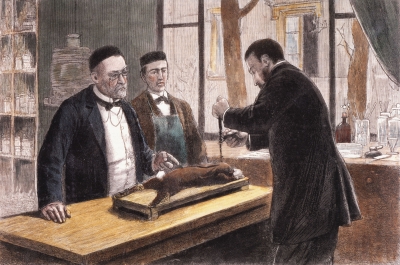
His research, which showed that microorganisms cause both fermentation and disease, supported the germ theory of disease at a time when its validity was still being questioned. In his ongoing quest for disease treatments he created the first vaccines for fowl cholera; anthrax, a major livestock disease that in recent times has been used against humans in germ warfare; and the dreaded rabies.
Pasteur produced vaccines from weakened anthrax bacilli that could indeed protect sheep and other animals. In public demonstrations at Pouilly-le-Fort before crowds of observers, twenty-four sheep, one goat, and six cows were subjected to a two-part course of inoculations with the new vaccine, on May 5, 1881, and again on May 17. Meanwhile a control group of twenty-four sheep, one goat, and four cows remained unvaccinated. On May 31 all the animals were inoculated with virulent anthrax bacilli, and two days later, on June 2, the crowd reassembled. Pasteur and his collaborators arrived to great applause. The effects of the vaccine were undeniable: the vaccinated animals were all alive. Of the control animals all the sheep were dead except three wobbly individuals who died by the end of the day, and the four unprotected cows were swollen and feverish. The single goat had expired too.
As with other infectious diseases, rabies could be injected into other species and attenuated. Attenuation of rabies was first achieved in monkeys and later in rabbits. Meeting with success in protecting dogs, even those already bitten by a rabid animal, on July 6, 1885, Pasteur agreed with some reluctance to treat his first human patient, Joseph Meister, a nine-year-old who was otherwise doomed to a near-certain death. Success in this case and thousands of others convinced a grateful public throughout the world to make contributions to the Institut Pasteur. It was officially opened in 1888 and continues as one of the premier institutions of biomedical research in the world. Its tradition of discovering and producing vaccines is carried on today by the pharmaceutical company Sanofi Pasteur.
Credit : Science History
Picture Credit : Google




